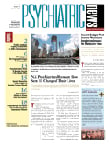Freedom
By Jonathan Franzen
Farrar, Straus, and Giroux
562 pages
Successful therapy can hinge on the effective use of countertransference. Mastering a negative countertransference, however, can be extremely difficult when dealing with some patients. The weak, insecure, and selfish people in Jonathan Franzen's new novel, Freedom, represent that challenge.
Psychiatrists can easily imagine any of this book's unlikeable characters in treatment and the subsequent difficulties in understanding their willful actions and self-absorption.
Married couple Patty and Walter Berglund are central to the novel. These "young pioneers" superficially represent the American ideal. They rehab their old house, recycle, and raise two children in St. Paul, Minn. Life is not, however, sunshine and roses at the Berglund's home. It never was. The simmering discontent erupts early in the novel when Patty slashes the neighbor's tires, Walter takes a job in Washington, D.C., and their rebellious son, Joey, moves in with the right-wing neighbors.
Franzen has for many years shown an uncanny ability to chronicle the precipitating and predisposing factors contributing to each of his characters' psychopathology. Understanding Patty's privileged yet difficult childhood in New York, for example, sheds light on her development into a disingenuous adult. A date-rape incident in which her parents' solicitude extended to the culprit, the son of wealthy politicians, prompted Patty's move to faraway Minnesota.
Insecure attachments then manifest themselves as Patty desperately clings to a sociopathic heroin addict and pathetically accepts romantic advances made by Walter, only to gain access to his philandering roommate, Richard Katz.
Walter is from rural Minnesota and "the small-town son of an angry drunk." Despite naïve efforts to be a do-gooder, Walter can't seem to escape the "bludgeoning daily misery and grievance that depressive male Berglunds evidently needed to lend meaning and substance to their lives." His complacency makes him oblivious to the needs of his wife and children. Franzen superbly captures the subtle "sibling rivalry" between Walter and Katz that builds on every insecurity.
Freedom's depiction of the Berglunds' deterioration is sometimes poignant, but often trite. As with therapy sessions, this novel can be tedious, awkward, and disappointing. Readers who persevere, however, are rewarded with the chance to explore many psychodynamic themes and countertransference issues.
Reviewers from Esquire and the New York Times have, respectively, called Franzen's new fiction "the great American novel" and a "masterpiece." I don't believe that either bit of praise is merited, but one thing is certain: if Freedom represents contemporary America, psychiatrists will be in business for a long time.


